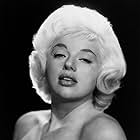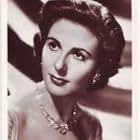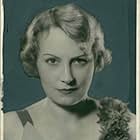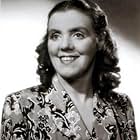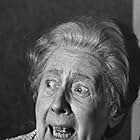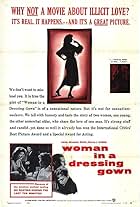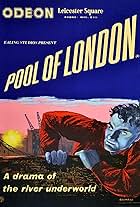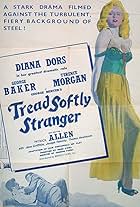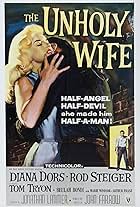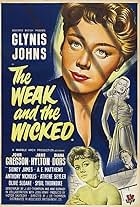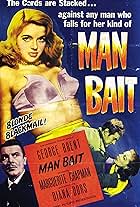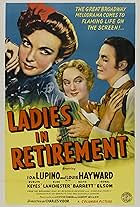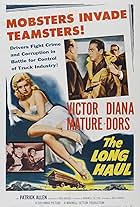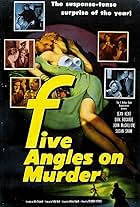IMDb RATING
7.1/10
1.6K
YOUR RATING
Locked in her cell, a murderer reflects on the events that have led her to death row.Locked in her cell, a murderer reflects on the events that have led her to death row.Locked in her cell, a murderer reflects on the events that have led her to death row.
- Nominated for 3 BAFTA Awards
- 4 nominations total
Mary Mackenzie
- Maxwell
- (as Mary MacKenzie/Mary Mackenzie)
Storyline
Did you know
- TriviaOften linked to the Ruth Ellis case, the novel and script were written two years before her trial and hanging, according to director J. Lee Thompson's biography. The resemblance was said to be coincidental.
- GoofsWhen Mary Hilton carries out the murder, she fires seven shots from a six shot revolver. There are cuts between a few different camera angles, but this all takes place as her victim slowly falls to the ground. There is no time to reload.
- ConnectionsFeatured in Empire of the Censors (1995)
Featured review
True "Blonde bombshells" of a starring nature come along only once or twice in a decade, and the number from, say, 1930 to 1960 is not all that many: Jean Harlow, Lana Turner, Marilyn Monroe, Diana Dors, Jayne Mansfield, Kim Novak, and that about does it. Of these, Harlow died too young and as an actress was memorable mainly in comedy, Turner turned into a very good actress as the years passed, Monroe was greatly loved but her true acting talent beyond her natural charisma was not really all that great, and Novak was passable. Mansfield was Mansfield. Diana Dors, however, despite her 'blonde bombshell' reputation and being probably the least beautiful of that group (one could hardly call her even very pretty) was a very legitimate actress, out of RADA, and gave excellent acting performances right from the start of her film career. Unfortunately, nobody seemed to notice at the time, which may have been her own fault for letting that reputation get out of hand.
This is the very best I have seen her, and her outing here as the doomed murderess is about as good a lead female performance as any to be seen in English films of the 1950s. It is truly amazing that both her performance and this film are not better known. Maybe the Hollywood-made I WANT TO LIVE of two years later ended up stealing this film's thunder, as they both cover the imprisonment and pending death of the protagonist. But only a portion of Susan Hayward's performance takes place inside prison walls, whereas in this film, outside the opening and some flashbacks, the entire story takes place in less than 20 days in a holding cell, perhaps 20 x 25 feet in size, and goes outside it only when the prisoner is allowed out for exercise in a high-walled yard. That there are always two warders taking shifts in the holding cell with Dors, tending to her every need but also imposing a strict regimen upon her, somehow adds to the total claustrophobia of the film, and it is irrepressibly morbid from beginning to end. But it is also terrific! Although the major burden falls on Dors, every performance in the film save one is exceptional, that one being Michael Craig's as her suicidal boyfriend. Craig is a good actor, but he was the wrong choice here, as he simply never really seems like the kind of guy who could be brought to suicide by unrequited love. Lawrence Harvey might have been perfect for it. But the great Yvonne Mitchell, as the youngest warder, is superb. It seems as though, from beginning to end, she has but one expression, which never changes, on her face, yet we see the feelings she is hiding underneath at every moment, and ultimately learn that those feelings are not confined to only the prisoner's situation.
Some reviews have mentioned this film as an indictment of capital punishment, but I don't see it that way, and only once in the entire film is anything said in that direction: One of the warders says that we mustn't forget the person Dors murdered, and another one answers that "...another death will not bring her back". Unlike in the Hayward film, we know right from the beginning that Dors is guilty of this crime, and although to the very end she never repents the murder, we still feel sympathy for her (I felt a lot more for her than for the Hayward character), surely a reaction engendered by the excellent screenplay, Dors' superb performance, and J. Lee Thompson's inventive direction.
Given the budget and the acting talent on view here, I do not see how this film could have possibly been any better, and it should prove a major discovery to anyone now seeing it for the first time.
This is the very best I have seen her, and her outing here as the doomed murderess is about as good a lead female performance as any to be seen in English films of the 1950s. It is truly amazing that both her performance and this film are not better known. Maybe the Hollywood-made I WANT TO LIVE of two years later ended up stealing this film's thunder, as they both cover the imprisonment and pending death of the protagonist. But only a portion of Susan Hayward's performance takes place inside prison walls, whereas in this film, outside the opening and some flashbacks, the entire story takes place in less than 20 days in a holding cell, perhaps 20 x 25 feet in size, and goes outside it only when the prisoner is allowed out for exercise in a high-walled yard. That there are always two warders taking shifts in the holding cell with Dors, tending to her every need but also imposing a strict regimen upon her, somehow adds to the total claustrophobia of the film, and it is irrepressibly morbid from beginning to end. But it is also terrific! Although the major burden falls on Dors, every performance in the film save one is exceptional, that one being Michael Craig's as her suicidal boyfriend. Craig is a good actor, but he was the wrong choice here, as he simply never really seems like the kind of guy who could be brought to suicide by unrequited love. Lawrence Harvey might have been perfect for it. But the great Yvonne Mitchell, as the youngest warder, is superb. It seems as though, from beginning to end, she has but one expression, which never changes, on her face, yet we see the feelings she is hiding underneath at every moment, and ultimately learn that those feelings are not confined to only the prisoner's situation.
Some reviews have mentioned this film as an indictment of capital punishment, but I don't see it that way, and only once in the entire film is anything said in that direction: One of the warders says that we mustn't forget the person Dors murdered, and another one answers that "...another death will not bring her back". Unlike in the Hayward film, we know right from the beginning that Dors is guilty of this crime, and although to the very end she never repents the murder, we still feel sympathy for her (I felt a lot more for her than for the Hayward character), surely a reaction engendered by the excellent screenplay, Dors' superb performance, and J. Lee Thompson's inventive direction.
Given the budget and the acting talent on view here, I do not see how this film could have possibly been any better, and it should prove a major discovery to anyone now seeing it for the first time.
- joe-pearce-1
- Aug 29, 2015
- Permalink
- How long is Yield to the Night?Powered by Alexa
Details
- Release date
- Country of origin
- Language
- Also known as
- Umfange mich, Nacht
- Filming locations
- Italian Gardens, Hyde Park, London, England, UK(romantic scene between the lovers/later scene with Dors reading newspaper)
- Production companies
- See more company credits at IMDbPro
- Runtime1 hour 39 minutes
- Color
- Aspect ratio
- 1.37 : 1
Contribute to this page
Suggest an edit or add missing content









